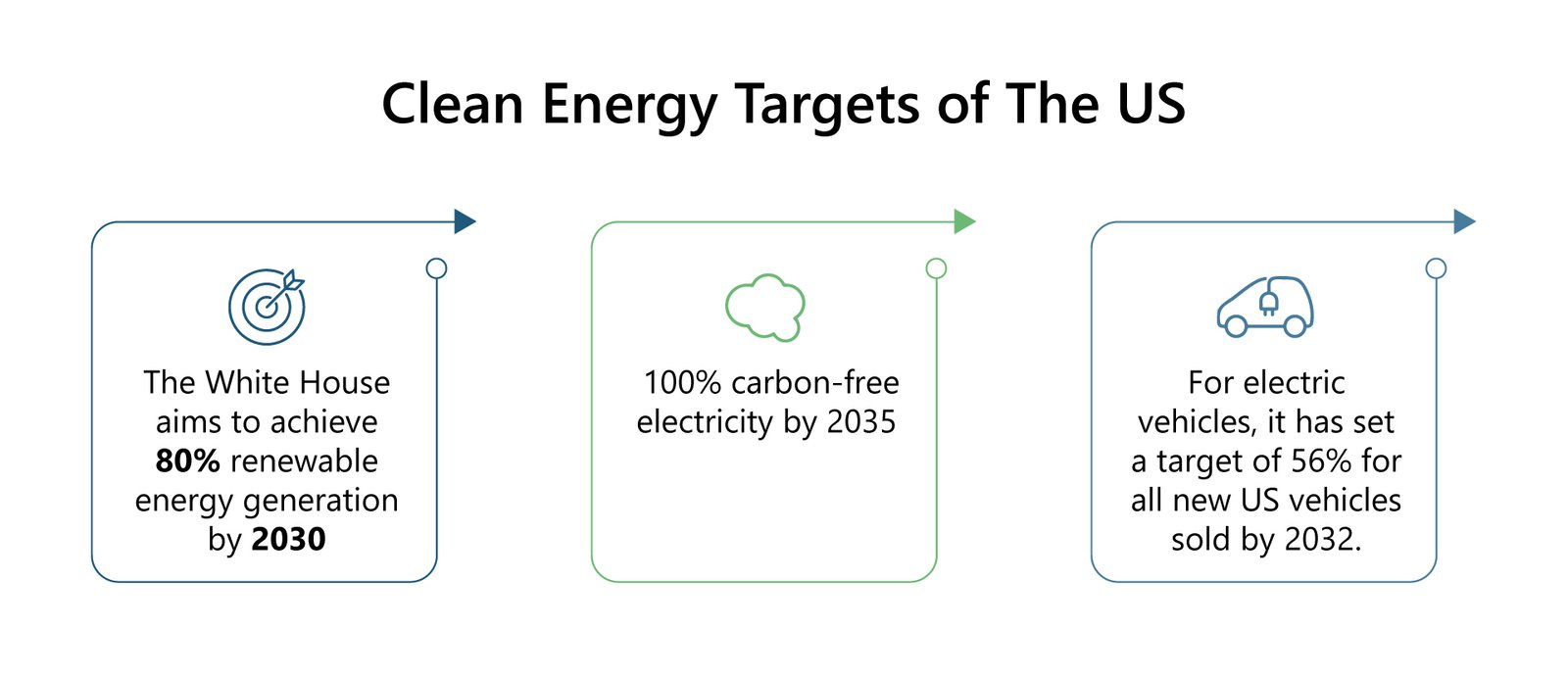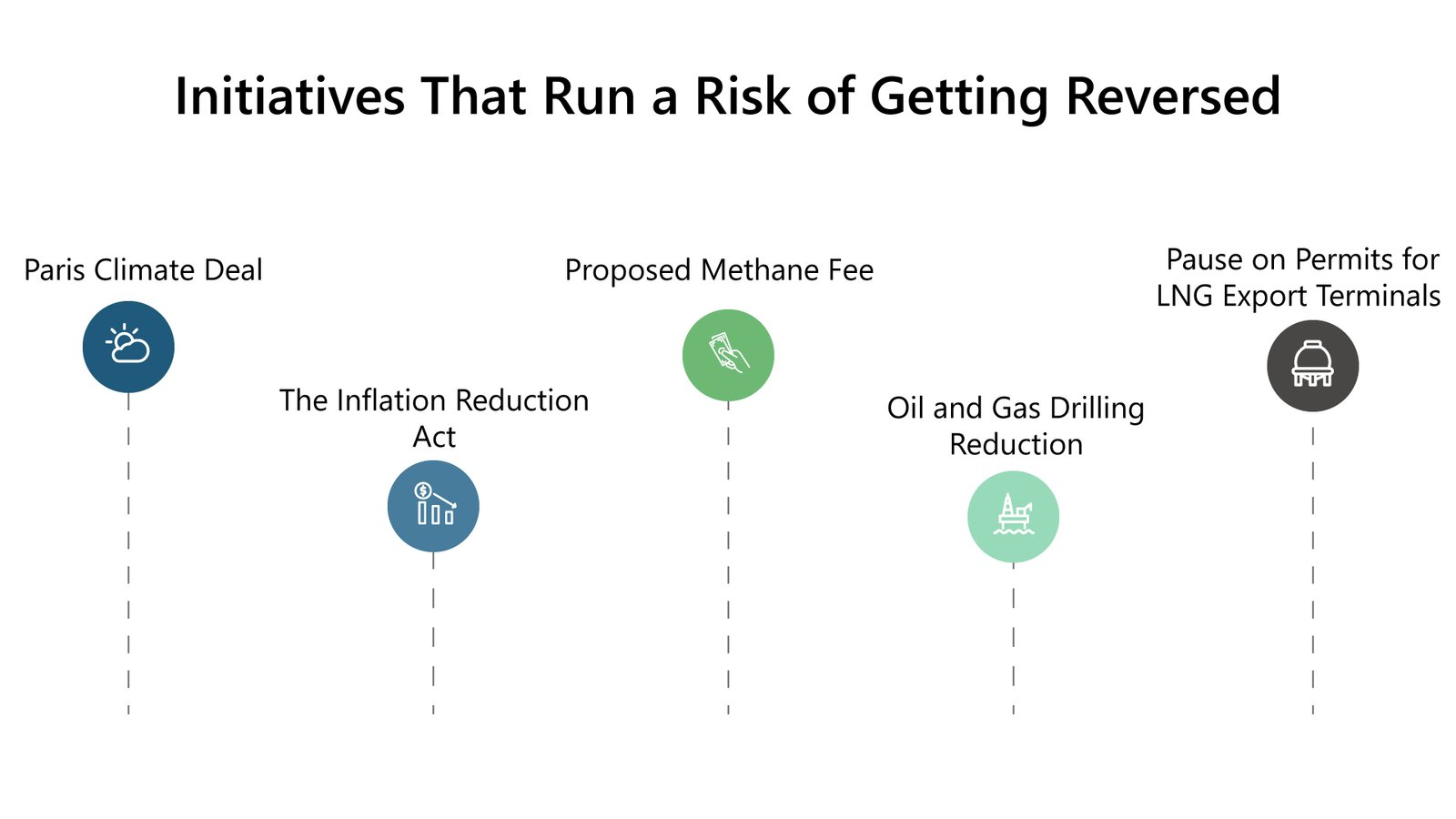- The US is making strides to move away from fossil fuels and eventually decarbonize the energy sector.
- The White House aims to achieve 80% renewable energy generation by 2030 and 100% carbon-free electricity by 2035. On the other hand, for electric vehicles, it has set a target of 56% for all new US vehicles sold by 2032
- However, the impact of elections will not be limited to clean energy initiatives but will extend to the power grid equipment market.
Under the Biden Administration, the US is making strides to move away from fossil fuels and eventually decarbonize the energy sector. The present administration has set aggressive targets for deploying renewable generation capacity and electrification of the transport sector, which releases tremendous amounts of carbon emissions.
The White House aims to achieve 80% renewable energy generation by 2030 and 100% carbon-free electricity by 2035. On the other hand, for electric vehicles, it has set a target of 56% for all new US vehicles sold by 2032.

Figure 1: Clean energy targets of the US.
Source: PTR Inc.
However, the US is heading towards an election in November, and the Democrats could lose the White House to Trump. This possibility has placed a range of key initiatives undertaken by the Biden Administration to create an enabling environment for the transition to clean energy at high risk. It is noteworthy that the impact of the elections will surely extend from clean energy initiatives to the power grid equipment market that PTR covers.

Figure 2: Initiatives that run a risk of getting reversed.
Source: PTR Inc.
Clean Energy Initiatives that Run a Risk of Getting Reversed
Major initiatives that risk getting reversed or halted include rejoining the Paris Climate Deal, the Inflation Reduction Act, the proposed methane fee, oil and gas drilling reduction, and a pause on permits for LNG export terminals.
Paris Climate Deal
The Paris Agreement is a legally binding international treaty that was adopted by 196 parties at the UN Climate Change Conference (COP21) in 2015. The treaty aims to curtail the increase in the global average temperature to well below 2 degrees Celsius above pre-industrial levels while pursuing efforts to limit the temperature increase to 1.5 degrees Celsius compared to pre-industrial levels.
The US withdrew from the Paris Agreement under the first Trump Presidency, but once Biden took office, the US rejoined. However, there is a possibility that if Trump becomes President again, the US will again pull out of the Paris Agreement.
The Inflation Reduction Act
Through the Inflation Reduction Act, the Biden Administration unlocked billions of dollars in subsidies that aimed to facilitate the adoption of renewable energy, electric vehicles, battery energy storage, heat pumps, etc.
Trump’s advisors and associates clearly indicated that they would move to scrap the IRA as well. However, scrapping the IRA will be tricky as the majority of subsidies under the IRA are reaped by the Republican states.
Proposed methane fee and oil and gas drilling reduction
The US Environmental Protection Agency has proposed a waste emission charge for methane for oil and gas facilities that produce emissions of over 25,000 metric tons of carbon dioxide equivalent. For methane emissions reported in 2024, the WEC is USD 900 per metric ton. WEC is expected to increase to USD 1200 per metric ton for emissions reported in 2025 and to USD 1500 per metric ton for emissions reported in 2026 and beyond.
It is anticipated that the Trump Administration will move to scrap the proposed methane fee for the oil and gas sector. Additionally, it will push to expand the US Interior Department’s five-year offshore oil and gas leasing program.
Pause on permits for LNG export terminals
The Biden Administration paused permits for LNG export terminals in order to ascertain the impact of LNG exports on energy costs, energy security, and the environment. When this article was being written, nearly 17 projects were awaiting approval from the Department of Energy to proceed. Though, recently, a federal district court judge has lifted pause on permits for LNG export terminals, it didn’t order the Department of Energy to approve or set a deadline for pending applications.
In a bid to usher in a new era of the fossil fuel industry, the Trump Administration is likely to expedite the process that grants permit for LNG export terminals. Notably, the US is the biggest exporter of LNG, with the exports growing exponentially since the first cargo shipped from Louisiana in 2016.
Looking Ahead
The US is headed toward Presidential elections at the end of 2024, and there is a possibility that Trump may become President for the second term. If Trump and Republicans, who have been historically pro-fossil fuel, win the election, then the fossil fuel industry in the US is expected to thrive, but at the cost of clean energy initiatives taken by the Biden Administration.
The clean energy initiatives that will suffer the most include the Paris Climate Deal, the Inflation Reduction Act, the proposed methane fee, the reduction in oil and gas drilling, and a pause on permits for LNG export terminals. Notably, rolling back the IRA may become a tricky exercise for the Trump Administration as the subsidies benefit mostly the Republican states in the US.
However, the impact of elections will not be limited to clean energy initiatives but will extend to the power grid equipment market. These clean energy initiatives have created an enabling environment for the deployment of renewable energy and electrification of the transport sector. In order to facilitate the integration of renewable energy and increased demand due to the electrification of the transport sector, the utilities are expanding and upgrading the country’s grid infrastructure. This has been driving the demand for power transformers, distribution transformers, switchgear (specifically MV switchgear), and HVDC transmission systems, which is expected to suffer in case Trump makes it to the White House.
Europe: +49-89-12250950
Americas: +1 408-604-0522
Japan: +81-80-7808-1378
GCC/Rest of APAC: +971-58-1602441
Recent Insights
Impact of the Russia-Ukraine Crisis on Energy Markets
The global spotlight is on the Russia-Ukraine crisis, which has been responsible for wreaking havoc on international fossil fuel markets. Western powers responded to the crisis by proposing a number of sanctions on Russia, including ones on its fossil fuel exports....
Energy Security Concerns Post the Russia-Ukraine Conflict to Trigger Growth in the UK’s HVDC Market
• Following the Russia-Ukraine conflict, the UK has increased the target for its offshore wind generation capacity to 50 GW by 2030.• Currently, projects accounting for 86 GW of generation capacity are in the pipeline in the UK and are expected to be realized in the...
Meet Our Team at Hannover Messe 2022
Hannover Messe 202230 May - 2 June [dsm_text_divider header="Venue" color="#FFFFFF"...
Overview of VSC & LCC Market (2016-2020)
With a global increase in energy demand, there is an apparent trend shift in the power grid with emphasis on decarbonization and digitization. Consequently, we see the growth of intermittent distributed energy resources. This trend shift is causing HVDC to become one...
Finland’s Success with Nuclear Repository to Affect Energy Mix in Countries
According to Power Technology Research, Finland’s electricity generation installed capacity accounted for 15.16 GW in 2020. Wind and solar accounted for 2.58 and 0.25 GW of installed capacity respectively. Finland’s nuclear waste repository at Onkalo will cost...
The Role of HVDC in the U.S. Energy Transition
In 2020, coal production in the U.S. declined 24% year over year accounting for the lowest coal production since 1965 (per . Electricity generated from renewables has been growing and surpassed generation from coal in 2020. President Biden has set a target to install...
European Climate Law to be the Lifeline out of Pandemic
The pandemic shrunk the EU’s economy by 6.1% in 2020. The European Climate Law proposes a 55% reduction in net greenhouse gas emissions by 2030, compared to 1990. A European scientific advisory board on climate change is established under the European Climate Law. In...







